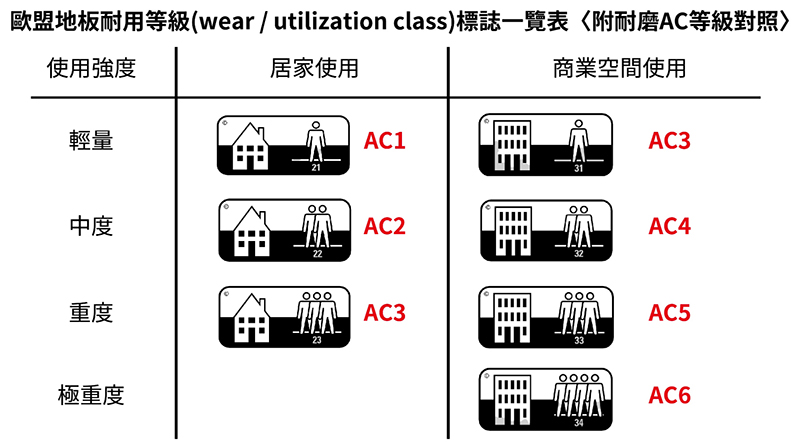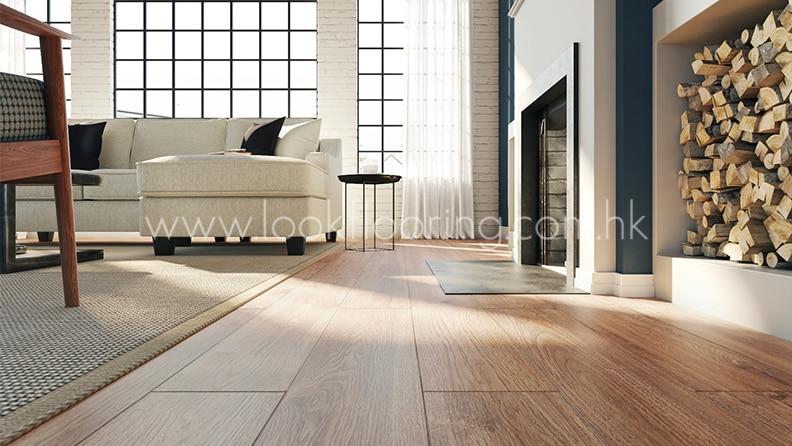Trivia
About Laminate
Laminate flooring, also known by some as “seamless flooring,” is primarily composed of four layers: a wear-resistant layer, a decorative layer, a core layer, and a moisture-resistant balancing layer. Laminate flooring comes in thicknesses of 8mm, 10mm, 12mm, and 14mm, and is considered one of the most scratch- and wear-resistant flooring options currently available on the market.

Surface Layer (Overlayer): Aluminum Oxide (Al₂O₃)
The surface layer is made of aluminum oxide (Al₂O₃), a type of mineral coating similar to the raw materials used in making ceramics and glass. It naturally possesses high wear resistance, impact resistance, heat resistance, and stain resistance, effectively combining durability with protection against moisture intrusion.
The abrasion resistance rating depends on the density of aluminum oxide, categorized from AC1 to AC6—the higher the number, the greater the wear resistance. For general household use, AC3 or above is sufficient.
AC ratings are based on the European standards EN13329 / EN438-2. According to commercial usage levels, the European classification includes 31, 32, and 33, representing light, medium, and heavy commercial use respectively. If it's suitable for commercial use, it's certainly more than adequate for residential settings.
Each usage level corresponds to different abrasion resistance ratings, as shown in the table below.

Decorative Paper
The decorative layer is a sheet of paper printed with wood grain patterns, which determines the realism of the flooring’s wood appearance.
To assess how realistic the wood grain looks, one should not only consider the color and pattern, but also pay attention to additional craftsmanship techniques—such as wave-like textures, embossed finishes, or more advanced synchronized patterns (where the embossed texture aligns precisely with the printed wood grain).
These techniques involve higher production costs, but result in a look that is much closer to real wood.
Core Layer
The core layer uses HDF (High-Density Fiberboard), which is made from wood chips sourced from sustainably managed forests. These wood chips are ground into short fibers, then mixed thoroughly with melamine (C₃H₆N₆), and finally formed under high temperature and pressure through thermoplastic compression.
This process not only reduces the use of forest resources, but also creates a dense material that can effectively block moisture from the ground, helping to prevent warping or damage to the flooring.
Moisture-resistant balancing layer (balances the pressure of the flooring during production; moisture-resistant)
The moisture-resistant balancing layer is a layer of kraft paper with a certain strength and thickness, impregnated with resin.
It is used during the production process to balance the pressure of the flooring, and serves to prevent moisture and deformation.
Here are the characteristics of laminate flooring:
- Highly wear- and scratch-resistant — not easily damaged by moving furniture, office chairs, or carts
- Feels like real wood — slightly warm, not hard, and has elasticity.
- Water-repellent and easy to clean — surface is anti-static, so dust and hair don’t stick easily. Can be cleaned with a slightly damp cloth or a robot vacuum (do not wet mop).
- Not waterproof — although it repels water better than solid wood flooring, it cannot handle large amounts of water. Avoid wet mopping, and be cautious with pets to prevent moisture damage from urine.
- Prone to expansion and contraction — made mainly from wood powder, so it easily reacts to humidity. Leave an 8mm gap at the wall edges during installation.
- Requires edge accessories — although European climates may not need them, Hong Kong’s high humidity makes them necessary. Many options are available: single-edge, double-edge, high-low, stair, L-shape, etc., to suit different environments.

